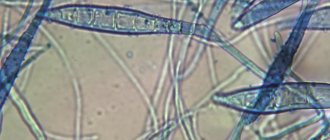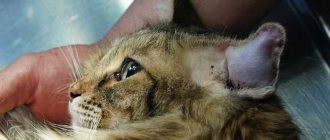The presence of parasites in an animal’s body is a pressing problem for domestic cats. The fact whether the pet is walked on the street or lives exclusively in the apartment is not significant.
An animal can become infected by eating raw meat or poorly cooked fish, licking scraps from a trash can, or simply lying among street shoes. White worms in cats are often found even in healthy-looking animals. When faced with a problem, the owner must treat the pet and take preventive measures.
What to do if your cat has white worms?
Worms enter the animal’s body through the digestive tract, which is where their spread begins. By sticking to the walls of the mucous membrane, worms cause local irritation, erosion, and minor hemorrhages. Feeding on the host's blood, the parasites take away some of the nutrients. Toxins released during the life of worms poison the body.
Larvae or worms can be seen in the cat's feces and on the fur around the anus. Sometimes the worm hangs directly from the anus.
The animal must be shown to a veterinarian. A stool test for worms may not be informative. Therefore, a specialist does not always prescribe such a study. Determining the type of worms is important when choosing treatment.
The pathogen is determined based on the clinical picture and etiology (when the doctor, based on the stories of the pet owner, determines what events preceded the infection, which will indicate to him the source of infection and the type of pathogen).
What type of worms are these?
- round (nematodes);
- tape (cystodes);
- flat (flukes or digenetic flukes).
Why is it important to determine the type of pathogen? Because one drug may be effective against only one class of worms and not affect others.
The presence of white worms in an animal’s feces indicates one of the two most common diseases of parasitic origin:
- In the first case, the causative agent is Toxocara, a type of cat roundworm.
- In the second - dipylidium or cucumber tapeworm.
Toxocariasis
Feline toxocara most often affects kittens under three months of age. In adult animals, the worm larvae become encapsulated and do not develop until sexual maturity. The owner may notice thin, long white worms ranging in size from 6 to 10 cm in the kitten’s stool. This type of helminth is a nematode. Externally, the parasite resembles a thread-like formation with a pointed end.
The infection can be transmitted from mother to fetus, in which case the kittens are born already infected. Reservoir hosts (capable of transmitting infection) can be various animals (for example, rodents) and insects, including earthworms and flies. A kitten becomes infected through contaminated objects, after swallowing insects, eating raw meat or rodent carcasses.
In the pet's intestines, worm eggs mature into larvae and migrate to the lungs. From there, they cough up and return with saliva to the gastrointestinal tract, where they transform into adults capable of laying eggs.
Characteristic signs of the disease:
- dull coat;
- weight loss;
- apathy;
- sour eyes;
- bloated stomach;
- coughing;
- temperature increase;
- vomiting, diarrhea mixed with blood.
A severe degree of infestation can cause the death of the animal. The helminthic mass clogs the intestinal lumen, impairs the passage of food, and in the worst case, leads to rupture of the intestinal walls.
Danger of infection for humans
Toxacara cat eggs are ubiquitous in the environment. Their microscopic dimensions (60-90 microns) do not allow them to be visualized without special equipment. They may be present on the animal's fur, getting there during licking.
Young children are especially at risk of infection because they spend a lot of time on the floor, often pick up and lick dirty objects, and play in a dirty sandbox. For adults, the infection awaits on unwashed fruits and vegetables. Toxocara can be carried by ordinary flies that have previously sat on a contaminated surface.
Humans and other mammals are reservoir hosts for Toxocara, in which the worm cannot develop to a sexually mature individual.
However, in the intestines, eggs are able to turn into larvae and migrate through the bloodstream to the lungs, liver, brain, eyes and other organs.
Having reached its habitat, the larva forms a dense capsule around itself, which clogs the blood vessels and disrupts blood circulation in the organ.
In humans, infection is often asymptomatic. The parasite will begin to manifest itself only when the larvae migrate into organs and tissues.
The extent of the disease will depend on the ability of the immune system to resist infection.
Due to an insufficient response, in rare cases, serious neurotic pathologies or diseases of the visual organs may develop, leading to complete blindness.
Toxocara can certainly be called dangerous to humans, but basic hygiene rules, such as washing hands before eating and handling food, greatly reduce the risk of infection.
Dipylidiasis
The disease is caused by a tapeworm, the cucumber tapeworm. In the body of an animal, the parasite reaches a length of 50 cm. Single individuals do not cause much discomfort. However, with a massive accumulation, worms can cause intestinal obstruction and lead to the death of the cat.
The disease is characterized by general symptoms such as bloating, indigestion, emaciation and loss of appetite. Toxins released by the worm can provoke neurotic disorders in the cat. Pets with a severe degree of the disease experience seizures resembling epileptic seizures.
The animal becomes infected mainly from fleas. The worm's segments (individual segments of its body) are released into the environment with the pet's feces. Outwardly, they look like cucumber seeds, reaching 5-6 mm in length.
Small white worms in a cat can stick to the fur from the anus, but most often the owner discovers the parasites by cleaning the litter box after the pet.
Movable white flatworms will be visually detected in the feces.
The segments of the worm are a shell that hides a cluster of eggs. After the wall is destroyed, the eggs come out. They are partially found on the animal's fur, but in this state they are not dangerous.
The flea, being a larva, swallows eggs, from which the parasite develops in the body of the insect to a cysticercoid - an invasive stage (capable of causing infection). The animal, while licking itself, swallows an infected flea. In the cat's body, the parasite develops into an adult, gaining a foothold in the intestines.
Danger of infection for humans
Dipylidiasis is a disease that can affect people. However, in humans, cases of infection are recorded extremely rarely (no more than once a year). The fact is that the parasite is dangerous only at the stage of larvae, which live in the body of a flea, therefore, in order to become infected, a person needs to swallow an infected insect. Under normal conditions this is practically impossible.
A third of identified cases of the disease are found in children under 6 months of age. Infants who are in close contact with animals are indeed capable of accidentally ingesting parasitic insects.
Treating white worms in cats
For the specific treatment of roundworms in kittens, drugs based on mebendazole and albendazole are used. Veterinarians often advise giving a cat the human drug “Vermox” in tablet form at a dose of 20 mg/1 kg of body weight for three days. The medicine is fed on an empty stomach once a day.
The broad-spectrum drug Milbemax . Its main components are Milbemycin oxime and Praziquantel, which are active against most common nematodes and cestodes.
The medicine is available in tablet form in a separate dosage for kittens and adult cats. The dose is calculated based on the proportion of 2 mg Milbemycin oxime and 5 mg Praziquantel per 1 kg of animal weight. The medicine is given once with food.
Dipylidiasis
The disease is treated with drugs based on Praziquantel. Owners should pay special attention to the fight against fleas, since after treatment the animal can become infected again if the insects are not removed.
For the treatment of dipylidia, there are various combination drugs in convenient dosage forms, such as suspensions or drops on the withers. However, veterinarians prefer tablets, since in this form the substances are most effective.
The complex drug Drontal is often prescribed for cucumber tapeworm.
Its action is based on Pyrantel and Praziquantel. The medicine removes round and tapeworms from the body. One tablet is designed for 4 kg of animal weight. The drug is given once with food.
Prevention of re-infection
Helminthiasis is a dangerous disease for any animal. Worms from cats can be transmitted to humans. Compliance with basic hygiene rules will protect against infection, and regular prevention will keep your pet healthy.
Source: https://glisty.su/belyj-glist-u-kota/
Folk remedies
The question of how to rid a cat of worms using folk remedies is asked by many owners. In addition to medications, worms can be removed from cats using folk remedies. If the recipes accumulated by the people help, then worms can be found in feces.
It is necessary to consult with your veterinarian before using traditional recipes.
Garlic tincture enema
Worms in cats can be expelled by cleansing the intestines.
- Finely chop 6 cloves of garlic.
- Pour 250 ml. water at room temperature.
- Leave for 2 hours.
- Give an enema.
Pumpkin seed infusion
- Peel 300 grams of pumpkin seeds, while preserving the green shell.
- Grind.
- Gradually pour in 50 ml of water at room temperature.
- Add 15 grams of honey.
- Mix.
- Give the resulting infusion to the cat for 1 hour.
- After 30 minutes, do an enema using warm water.
Herbal collection
Worms in cats can be expelled with the following herbal mixture.
Take 20 grams:
- Tansy flowers.
- Peppermint.
- Buckthorn bark.
- Wormwood.
- Wild carrot seeds.
- Brew 2 tablespoons of herbal mixture with a glass of boiling water.
- Give 3 tablespoons in the morning for 3 days.
Carrot juice enemas
- Squeeze approximately 20 ml of juice from fresh carrots.
- Do it once a day for 7 days.
Onion infusion
- Cut a small onion into 4 parts.
- Pour 1 glass of boiled water, but not boiling water.
- Give to your pet in the morning for a week.
Deworming (sorry, about worms...)
Pregnant animals are prescribed in the last third of pregnancy, lactating animals - 2-3 weeks after birth, only those drugs that have appropriate indications in the instructions (for example, Milbemax), otherwise they can harm the health of the offspring.
It would be correct to drive away worms 10-14 days before mating. If this has not been done, kittens should be wormed no earlier than 21 days after birth.
Unfortunately, infection of kittens with worms can even occur in utero, during childbirth and breastfeeding.
If the animal has a severe helminthic infestation (the kitten was picked up on the street), parasites are visible in the feces, the animal is vomiting worms, then anti-worm medications should be given under the supervision of a doctor, since the simultaneous death of a large number of helminths can cause poisoning of the body and there will be a need for an IV.
Prevention
As you know, it is easier to prevent a disease than to treat it later. If you follow some rules, you can protect not only the cat, but also yourself from these troubles, which are sometimes very difficult to deal with.
- If you do not give your cat raw meat or fish, you can avoid such a problem as worms in your cat. Raw foods must first be boiled and then fed to your pet.
- To prevent cats from getting worms, they need to be treated with anthelmintic medications once every 3 months.
- In order to avoid this problem, you need to keep your cat's litter box clean and disinfect it regularly.
- If you regularly treat your animal with a flea solution, your cat may not develop worms at all.
- Outdoor shoes should be stored in a special closet, away from the pet.
- It is necessary to do regular cleaning of the door mat.
- Do not pet the cat immediately after going outside; you need to wash your hands first.
- A bell on the animal's neck will prevent it from catching a mouse or bird, which could become a source of disease.
Prevention of the disease is important. If your pet is healthy, then the owner’s risk of contracting helminths will be significantly reduced, and a healthy animal will delight you with its playfulness and beautiful appearance.
Worms in cats. Cat, cat and kittens
Cats can become infected with a variety of intestinal parasites, including those commonly called worms. Infection with worms causes a number of symptoms.
However, sometimes in cats the disease is almost asymptomatic, and the infection can go undetected despite potentially serious health problems.
Some types of worms that parasitize cats can also pose a danger to human health.
What types of worms are most common in cats?
Roundworms (nematodes) are the most common internal parasite in cats. Similar to spaghetti, adult worms reach a length of 8-10 centimeters. Cats can become infected with these parasites in several ways.
Kittens can become infected with worms through the milk of infected mothers, while adult cats can become infected by eating infected rodents or the feces of sick cats. One of the most well-known parasites among roundworms is hookworm.
Hookworms are much smaller in size than other roundworms - less than 2-3 centimeters long. They live mainly in the small intestine. Because these worms feed on the blood of animals, they can cause life-threatening anemia, especially in kittens. Hookworm eggs are found in cat feces.
These then hatch into larvae that can infect other animals and humans by entering the body through skin contact or through contaminated food and water. Note that hookworms are more common in dogs than in cats.
Long and flat, tapeworms reach a length of 10-70 centimeters, and their body consists of numerous segments. Infection causes vomiting and weight loss.
Cats become infected with tapeworms by eating an intermediate host, such as infected fleas or rodents.
In an infected cat, you can often see segments (worm segments) that resemble grains of rice in the fur around the anus.
Unlike intestinal parasites, lungworms parasitize the cat's lungs. Most cats do not show any signs of having lungworms, but some develop a cough.
Snails and slugs are the most common intermediate hosts for this type of parasite, but cats typically become infected after eating infected birds or rodents.
How can a cat become infected with worms?
Although the methods of infection vary, one of the main methods is through eating the feces of infected animals. Cats can also pass worms to their kittens through their milk. A cat can also become infected with worms through raw meat, fish, other animals and humans.
In addition, many cats love to hunt flies, and flies are carriers of worm larvae.
What are the common symptoms of worm infestation?
Symptoms vary depending on the type of parasite and where it is located, but some common clinical signs include:
- Diarrhea;
- Worms that can be seen in the stool, or worm segments near the cat's anus;
- Bloody stool;
- Severely swollen and round belly;
- Weight loss;
- Vomit;
- Constipation;
- Cough;
- Labored breathing.
Which cats are more prone to infestation with worms?
Cats that are often outdoors, as well as those that regularly visit soil where other animals defecate, are more likely to become infected with worms.
Kittens and cats that are not taken to routine veterinary examinations and dewormed are most at risk of developing complications caused by internal parasites.
What should I do if I think my cat has worms?
It is worth taking your cat to a veterinarian who can confirm the presence of worms. The veterinarian can do this based on a stool analysis. Avoid self-diagnosis, as worms are not always visible and can be difficult to identify.
How to treat worms?
Please do not attempt to treat your pet yourself . First, it is important to identify what type of worms your cat has. Some medications are designed to kill tapeworms, but they will not be effective against roundworms.
And, for example, a drug such as Pyrantel is effective against roundworms (especially for ascariasis, hookworm disease), while it is mild, safe and does not cause intoxication, since it only immobilizes and does not kill worms that are excreted alive in the feces, but is useless when infected with tapeworms.
Broad-spectrum drugs (for different types of worms) can be very harmful and toxic. After such drugs, animals may feel unwell, and symptoms of intoxication are often observed:
- lethargy,
- weakness,
- nausea,
- vomit,
- diarrhea.
After diagnosing the type of parasite your pet has, your veterinarian will prescribe the most appropriate course of treatment.
Can I get worms from my cat?
Yes! Large numbers of worm eggs can accumulate in the area where cats defecate. People, especially children, who accidentally ingest such eggs may develop serious health problems. Nematode larvae can penetrate human skin and cause lesions. People can also become infected with tapeworms through infected fleas.
How to prevent a cat from becoming infected with worms?
- Keep your cat indoors or in an apartment and do not let it roam outside to avoid contact with infected cats, rodents, fleas and feces.
- Make sure your home, yard (if you live in a private home) and pets are free of fleas.
- Maintain good personal hygiene and wear gloves when cleaning the cat litter box. It is also important to clean up your cat's stool frequently.
- Ask your veterinarian to recommend a good medication to prevent infestation. Cats need to be dewormed twice a year, even if your pet doesn’t go outside. Deworming should also be done before vaccinations (to avoid complications).
If there are several animals in the house, everyone should be given the deworming drug at the same time. To get rid of worms, you need to give the drug twice with an interval of 10 days.
It is possible to defeat parasites!
Tips from our readers
I got rid of parasites in just a week! I was helped by a remedy that I learned about from an interview with a parasitologist.
The appearance of worms in cats is common, even in pets. It is difficult to completely eliminate parasite infection, because various factors can provoke the proliferation of parasites. In the article we will look at general and specific symptoms of infection, the first signs of the presence of helminths. We will also tell you how to independently identify worms in a cat.
The most common routes of infection:
- Thermally unprocessed foods, including raw meat, fish, unpurified water, chicken eggs;
- Insects, including fleas, flies, mosquitoes, through whose bites infection can spread;
- Contact with surfaces where eggs or worms are located. This could be shoes, garbage, etc.;
- Communication with other infected animals.
There are many ways of infection. It is quite difficult to identify them on your own; it is more important to notice in a timely manner that your pet has already become infected and you need to take measures to treat it.
What do worms look like in cats - the main characteristics of helminthiasis
Various categories of parasites constantly infect muscles, liver, and bronchi. They can live not only in humans, but also in domestic animals. To understand how dangerous these individuals are, it is worth knowing that these individuals are able to infect all the most important organs.
The pet, as a rule, experiences complete exhaustion of the body, the cat loses the shine of its coat, its appetite decreases, and the animal also begins to lose weight. Often worms begin to come out through feces and vomit, so it’s worth checking them from time to time.
To do this, you need to know what worms look like in cats.
If these problems exist, as well as if phenomena such as diarrhea and constipation are noted, it is worth taking your pet to a veterinary clinic, where appropriate laboratory tests will be carried out.
Main types of cat worms
Parasites of various types can quite successfully parasitize a cat’s body. There are roundworms, that is, nematodes, there are cestoses or tapeworms, and there are also helminths in cats that are characterized as trematodes, that is, flat flukes. Each of these types of parasites is able to infect a specific organ.
This category of parasites is the most common among all types of parasites. The most common “guests” in the body of a domestic cat are roundworms. Recognizing such parasites is quite easy and simple. They look a bit like spaghetti.
Their length is approximately 5 cm and can be even longer. Small kittens, as a rule, become infected with a disease such as ascariasis through the cat's milk.
She herself lets them into her body if she eats rats, unprocessed meat, and also in the process of contact with other infected animals.
Such parasites form a cluster in the intestines, thereby blocking the bile ducts. Parasites seriously damage the mucous membranes of the digestive organs. Worms of this type have a fairly strong toxic effect on the health of the cat. Other nematodes of round worms include the following two types:
- Hookworms.
- Toxascaridae.
The first ones are about 2 mm long, so they are quite easy to identify. These worms feed exclusively on blood. The second type is more noticeable, since these roundworms can reach 5 cm in length.
Helminths of this category, as a rule, parasitize the liver and other organs of the gastrointestinal tract.
It is worth noting that in a cat’s body such helminths can remain in an inactive state for a long time, so they are not easy to identify.
White tapeworms
In fact, these are special cestodes, which are characterized as flat and can reach 70 cm in length. The peculiarity of the worms is that the body of the helminth consists of a large number of segments. Each of them produces numerous larvae.
The infection process is usually carried out in a situation where the animal’s diet consists of raw, unheated fish and meat. In addition, there is a risk of getting an invasion through carriers of a different type - these could be fleas.
These worms parasitize strictly on the intestinal walls, along its entire length. For this reason, the process of identifying the disease can be much easier, since quite often segments emerge from the anus.
Among the main types of parasites in this category, we can note:
- Tapeworms, which can cause diphyllobothriasis. These parasites are quite easy to identify. They are wide in shape, and the length can reach one and a half meters. Such parasites settle exclusively in the intestines;
- This may be a special cucumber tapeworm that causes such a serious disease as destructive dipylidia. Such worms usually reach 30 cm in length and have a slight grayish coloration. Parasites are usually present in the intestines;
- Alveococcus. These are small worms, the length of which is not more than 4 mm, and they parasitize in the intestines.
- Flat flukes.
There is another type of worms that can be found in cats. These are trematodes, which are white thread-like worms. Their peculiarity is the presence of a large number of suckers, with the help of which they attach to the intestines.
Through such fastening, the mucosal membrane can be seriously damaged in a special mechanical way. Parasites are harmful because they have a serious toxic effect on cats.
These parasites are found much less frequently than other categories of helminths, but they are the ones that pose a mortal danger after infection.
The process of infection of an animal occurs after contact with an infected animal, after a cat digs in the soil, when eating freshwater fish, and so on. Such flukes are parasites that can destroy a person’s internal organs and tissues. It can parasitize not just the intestines, but also the lungs, bladder and liver.
Among trematodes there are such categories of helminths as a special pulmonary fluke, which in the process of parasitism cause paragonimiasis.
The length of this individual can reach 1 cm, and similar worms inhabit the lungs of cats, thereby forming numerous cysts and completely destroying lung cells, which then leads to the death of the animal. The second type of trematode is opisthorchis.
They reach approximately 5 mm in length. A similar type of helminth parasitizes the gallbladder and is present in the liver and pancreas.
General symptoms and main signs
Often parasites come out of the animal during the process of defecation, for example, after taking medication. In addition, the presence of helminths can be detected in the kitten's feces or when it vomits. It doesn’t really matter what type of worms the kitten has; the symptoms are usually all the same. The main features include:
- Presence of larvae in feces after taking anthelmintic medication. They can also exit from the anus;
- There are various stool disorders, for example, diarrhea, constipation, and all this can also alternate;
- A kitten may have worms themselves or small amounts of blood in their stool or if they vomit;
- If a kitten has parasites, you can often observe how it rides on its fifth point, the cause of which is severe itching;
- The animal begins to lose weight quickly, its appetite goes away or, on the contrary, it increases greatly;
- The kitten may have developmental delays;
- Hair may begin to fall out, the cat looks exhausted.
If worms are found in the feces of a kitten or an adult cat, you should immediately show the animal to a specialist. The veterinarian will certainly carry out various research methods and examine the presence of particles in the feces. As soon as a specific diagnosis is identified, the most effective treatment for the kitten and adult cats is prescribed.
It is recommended to treat a sick kitten using special anthelmintic drugs. At the same time, it is necessary to ensure that the pet does not vomit, since the roundworms will not be eliminated. The most effective remedies include medications such as:
- Praziquantel,
- Pirantel,
- Drontal,
- Vacation.
What types of parasitic organisms are there?
Veterinary parasitologists divide organisms that live and use the host into the following varieties:
- external, affecting the skin;
- subcutaneous, localized in the upper layers of the dermis;
- internal, parasitic on organs and blood.
Return to contents
Skin parasites
Lice eaters (wool eaters)
These ectoparasites in cats provoke the disease trichodectosis, can live in the fur and feed on hair, blood, and secretions of the sebaceous glands. Infection occurs only through contact with a sick animal, since they cannot exist in the external environment. The feline variety is an intermediate host of the squash tapeworm helminth, which can be transmitted to animals. Localized on the neck, tail, head. Signs:
This type of louse contributes to the formation of bald spots in your pet's fur.
- severe itching;
- the appearance of scratches and wounds on the skin;
- thickening of the stratum corneum of the affected areas of the epidermis;
- hair loss and bald spots.
You can get rid of cat lice using flea collars, drops, sprays, and shampoos. Best remedies:
Cat fleas
These are small arthropod parasites that do not constantly exist on the animal, but attack to feed on blood. Infection occurs through contact with a sick stray animal, in a nursery or pet hotel, or due to poor sanitation of the premises where the pet lives. You can pick up insects from dogs that live with a cat. Fleas carry brucellosis, plague, and rickettsiosis, which can affect cats and people. Cat parasites manifest themselves as:
Treatment is carried out with anti-flea drugs, such as:
Ear mite
The causative agent is the microorganism otodectes and provokes the disease otodectosis. A domestic cat becomes infected from a sick cat, as well as through contact with a rug, toys, or scratching post with which the carrier has been in contact. Symptoms:
- unbearable itching in the ear;
- discoloration of the skin on the bald patches and the inside of the ear to dirty brown;
- frequent head shaking;
- black-brown discharge from the ear that resembles asphalt;
- the appearance of pus if otitis media begins;
- anxiety, restlessness, aggression.
Insects are eliminated with ear medications such as:
Ixodid tick
This is a dangerous bloodsucker, since the diseases caused by the parasite are deadly for cats - borreliosis and tick-borne encephalitis. Ticks live in grass and low bushes and become active in May-June, remaining active until October. The insect jumps on a walking cat, crawls to the skin and bites into it. It can carry pathogenic microbes in its saliva, which enter the animal’s bloodstream and provoke a serious condition. A veterinarian must remove the tick. You can protect your animal with drops and collars. If a cat develops an infectious disease, the doctor prescribes therapy depending on the clinical picture.
Maggots on a cat
Particularly dangerous are eye, brain and pulmonary forms of damage, which lead to loss of vision, respiratory failure and death.
These are white larvae of flies that parasitize on weeping, purulent and gangrenous wounds of the animal. Worms belong to both external and internal forms, since they can exist in the intestines and spread to other organs. Infection occurs through the anus under the tail, introduction through contact with the soil, through the bite of a gadfly or flies, or ingestion of eggs from the fur while washing. Maggots are able to gnaw passages under the skin, penetrating into the deeper layers. Symptoms vary depending on location:
- severe pain and itching;
- formation of boils;
- cough mixed with blood and maggots;
- wounds on the eyes;
- vomit;
- diarrhea;
- dyspnea;
- temperature increase;
- aggression and anxiety.
With this problem, the animal’s wounds must be carefully treated.
Therapy includes the following methods:
- wound treatment;
- surgical removal of worms and areas of necrosis;
- use of antibiotics and cortecosteroid drugs.
Return to contents
Subcutaneous parasites
Scabies mite
Cat scabies are caused by notoedres, which causes the disease notoedrosis. These parasites appear in cats after contact with a sick animal. The mite penetrates the upper layers of the epidermis, where it leaves a thin white passage. Symptoms:
- severe itching, especially in the neck, head, muzzle;
- formation of pustules;
- thickening and roughening of the skin in the affected areas;
- the appearance of crusts after opening the ulcers;
- hair loss;
- aggression and anger due to constant itching.
Scabies can be treated with the following medications:
Sulfur ointment can be used if an animal is diagnosed with scabies.
- "Stop the itch";
- "Apit";
- "Chemi";
- "Immunoparasitan";
- Sulfuric ointment.
Return to contents
Demodicosis
The causative agent is the Demodex mite. A parasitic disease occurs when a microorganism invades the upper layers of the dermis and hair follicles. In healthy animals, the vital activity of the tick is suppressed by immune defense, so the main cause of the disease is decreased immunity, past infectious diseases, poor nutrition, regular stress, long-term antibiotic therapy, and the presence of other types of parasites. Signs:
- no itching;
- the appearance of pustules and discharge of pus;
- hyperemia of the affected areas;
- hair loss and scale formation.
Treatment includes several pharmaceutical groups, which include the following medications:
Internal parasites
Most often, cats are affected by the following worms:
- Nematodes. These are roundworms, which include roundworms, hookworms, toxocara, and heartworms.
- Cestodes. Tapeworms, mostly cucumber tapeworms, are found in cats.
- Trematodes. They belong to flatworms (liver flukes). Representatives: opisthorch, metorch, cat fluke.
Worms in cats: signs and treatment
Infection of an animal's body with worms - helminthiasis - is the most common disease of cats. Parasites pose a danger not only to the pet, but also to its owner; they are easily transmitted provided they exist in the same environment.
Helminths enter the animal's body from the outside. They are found everywhere: in water, soil, raw foods and much more.
Even if a pet has never crossed the threshold of an apartment in its life, this does not mean that it is immune from helminthiasis: worm eggs enter the home along with dirt stuck to shoes and dust on clothes.
Symptoms of cat infestation with worms
Signs that a cat has worms can be obvious (eg, chronic diarrhea, indigestion) or less noticeable. Even a caring owner may not notice lethargy, apathy, or decreased appetite right away, but once they notice it, they may attribute it to the cat’s special mood.
Cats suffer from various types of worms, and in order to properly treat, you need to know which parasite is preventing your pet from living.
Roundworms
One of the most common types of parasites that can be transmitted from animal to animal; dangerous to humans. The length of these worms reaches 5-10 meters, they are white or brown, tapering towards the end.
Sometimes worms come out along with the animal’s feces or vomit - this is the easiest way to diagnose their presence. But, of course, it’s better not to let things get to that point.
The presence of roundworms in a pet’s body can be determined by the following signs:
- The cat's belly swells, as if overeating or gaining weight for the winter;
- Appetite increases abnormally;
- The animal often has the urge to vomit;
- Constant diarrhea;
- Apathy, decreased activity.
Nematodes
Unlike roundworms, nematodes cannot be seen with the naked eye, and it is impossible to look for them in secretions. Once in the cat's body, they begin to suck blood, causing the animal to weaken and suffer from anemia.
If you do not notice the symptoms of nematode damage in time, the outcome can be very sad. The mortality rate among kittens from these parasites is much higher than among adults.
The presence of nematodes can be determined by the following symptoms:
- Blood in the animal's stool;
- Pain in the stomach (localization can be recognized by the positions that the cat takes, how it relates to stroking the belly, and so on);
- Chronic diarrhea.
Nematodes are also dangerous for people and can be transmitted to their hosts. The insidiousness of nematodes is that in adult cats a protective mechanism is triggered - they do not show signs of the presence of worms, and they are stored in their body until a “gap” appears in the immune system.
Solitaires
The spread of these parasites is directly related to fleas. If an animal has ever had fleas, then it is at risk. When a cat swallows a flea, it also swallows the tapeworm eggs that the cat carries.
They develop in the pet's body and lay new eggs. You can notice tapeworms on the cat itself (they are very small and white) or on its sleeping place, where dead individuals usually accumulate.
In appearance, they resemble crumbled rice - just as small and white. A cat has tapeworms if:
- She is losing weight and her appetite has increased significantly;
- White granular inclusions appeared in the animal's feces;
- White parasites accumulate under the tail, in the fur around the tail.
Heartworms
These parasites are quite rare in cats; their presence is more common in dogs. But if the animal has a lowered immune system, is sick or suffers complications from previous diseases, heartworms will not miss this opportunity. Cats become infected with them from mosquitoes - through their bite.
It is very difficult to identify this parasite, since there are no visible symptoms of worm infestation, while the cat weakens and may even die. The presence of heartworms is determined by several blood tests. Suspicion is also raised in the presence of heart and lung diseases.
Symptoms of infection
Signs of parasite infection are behavioral in nature, when the cat begins to behave in a special way, as well as physiological - changes in digestion, metabolic processes, and appearance become obvious.
General symptoms
There are basic or general signs of the presence of worms in an animal, but they are symptomatic of a number of diseases, so prior consultation with a veterinarian is required.
Typical manifestations of infection include:
- Bloating, barrel-shaped;
- Changes in appetite, its complete loss or vice versa – frequent demands for food;
- Problems with the gastrointestinal tract (gastrointestinal tract), manifested as vomiting, diarrhea, constipation;
- Discharge from the eyes of a purulent type, in the form of dried crusts;
- Weight loss, with appetite present;
- The coat becomes dull and falls out, which is explained by decreased immunity;
- Blood or worms themselves are observed in the stool.
Symptoms may vary and other signs may be added depending on the type of parasite. It is recommended to determine which worms the animal is infected with, since medications will be selected based on this.
Symptoms of tapeworm infection
When infested with tapeworms, in addition to general symptoms, the following may be observed:
- Complete refusal to eat;
- Irritation and a rash appear on the anus, the cat constantly licks the anus;
- The worms themselves are visible in the feces, fragments from the rectum may be visible (outwardly they look like grains of rice);
- Weight loss sharply;
- Apathy, the pet’s playfulness is lost;
The presence of tapeworms can be confirmed using tests, since external symptoms alone are not enough for diagnosis.
Signs of intestinal helminth infection
The term intestinal helminths includes most types of worms that live in the body. They can be recognized by the following signs:
- The cat loses weight, although loss of appetite is not observed, and sometimes worsens;
- Vomit;
- Bleeding of the intestines, noticeable visually on the surface of the anus, in the feces;
- Painful when palpated, the animal cannot be handled because it is experiencing discomfort;
- Anemia (anemia) or decreased hemoglobin, manifested in pale and dry skin, fatigue, drowsiness;











